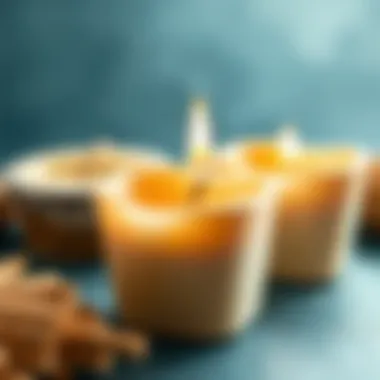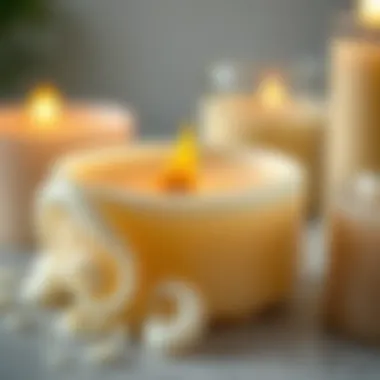The Ultimate Guide to Soy Wax Candle Molds


Intro
Exploring the world of soy wax candle molds can feel like diving into a vast ocean of creativity. For both budding enthusiasts and seasoned candle makers, understanding the nuances of these molds opens up a treasure trove of possibilities. With the growing trend toward eco-friendly products, soy wax has emerged as a popular choice, given its clean-burning properties and renewable nature.
This guide is designed to shed light on the different types of molds, the materials used to create them, and how to select the right mold for your specific candle-making projects. From the intricacies of each mold's design to the technical aspects of the candle-making process, we aim to provide thorough insights that appeal to your curiosity and creativity.
Whether you're crafting a centerpiece for an event, creating gifts, or simply exploring a new hobby, the art of candle making invites you to experiment. The information presented here will help you navigate not just the practicalities but elevate your craft, ensuring both safety and artistry.
In the coming sections, we will explore topics like mold materials, effective techniques for using molds, and important considerations to ensure your candle-making experience is both enjoyable and safe.
Preface to Soy Wax Candle Making
Candle making has emerged as a popular hobby and craft in recent years. Among the various materials available, soy wax stands out, not only for its sustainability but also for its exceptional burning properties. Understanding soy wax candle making is essential for anyone looking to create beautiful, high-quality candles that are both eco-friendly and visually appealing.
Understanding Soy Wax
Soy wax is derived from soybean oil, making it a renewable resource compared to traditional paraffin wax, which is petroleum-based. This aspect alone enhances its appeal among environmentally-conscious crafters. When you melt soy wax, it produces a clean burn with minimal soot, ensuring that your home stays fresh without the air pollution associated with conventional waxes. This is particularly vital for those with respiratory concerns or allergies.
Moreover, soy wax tends to hold fragrance beautifully, offering a strong scent throw that can fill a room without overpowering it. Many candle makers find that they can customize their scents by experimenting with different oils and additives. Additionally, because soy wax has a lower melting point, working with it can be a more forgiving experience, particularly for beginners.
Importance of Candle Molds
Candle molds are crucial tools for any candle maker. They define the shape and aesthetics of the final product, offering endless possibilities for creativity. Selecting the right mold can dramatically alter the look and feel of the candle.
By using molds, artisans can create a variety of styles—from classic pillar candles to intricate tea light designs. Not only do molds allow for unique shapes, but they also facilitate the layering of colors or scents, resulting in truly original creations.
Additionally, without proper molds, the pouring and cooling process can become disorganized, leading to uneven candles or unsightly surface textures. Therefore, understanding the forms and materials of molds used in soy wax candle making is indispensable.
“The right mold can transform a simple candle into a work of art.�”
In this section of the article, we explored the essentials of soy wax and the pivotal role that candle molds hold in the craft. By grasping these foundational elements, makers can better navigate the intricate world of soy wax candle making, ultimately leading to improved craftsmanship and creativity in their work.
Types of Soy Wax Candle Molds
When diving into the craft of candle making, understanding the variety of soy wax candle molds is pivotal. Each type has its unique characteristics, strengths, and attributes. This section will thoroughly examine different mold types, explaining why they matter and how they can elevate your candle-making game. By selecting the right mold, you not only enhance the aesthetic of your work but also optimize your manufacturing efficiency.
Silicone Molds
Silicone molds are among the most favored choices for soy wax candle makers. They offer a plethora of benefits, starting with flexibility. This feature makes it impressively easy to remove the finished candle without much effort or damage. The silicone surface is non-stick, allowing for a smooth release which is crucial for preserving the candle's intricate design.
Another significant advantage is that these molds come in a myriad of shapes and sizes, catering to both traditional and avant-garde design preferences. Whether you're after sleek geometric shapes or more whimsical forms, the options are virtually endless. Also, silicone molds are durable. They can withstand high temperatures, which is ideal when pouring hot soy wax. Some might say it’s like having a trusty sidekick throughout the candle-making journey.
Metal Molds
Metal molds represent a classic choice in candle making. Known for their sturdiness, these molds are usually made from aluminum or stainless steel, allowing for consistent heat distribution. This characteristic can lead to a more evenly set candle. However, there's a bit of a trade-off—removing the candle can require a gentle tug, and you must ensure that the wax isn't left to harden too long. A well-timed release can save you from a botched candle.
One of the appealing aspects of metal molds is their professional look. They often yield a beautiful finish that can stand as centerpieces. Yet, it's essential to consider that they are generally more expensive than silicone options, but many artists feel that the resulting product is worth the additional investment.
Plastic Molds
Plastic molds serve as a budget-friendly alternative for many budding candle makers. They come in diverse shapes and designs and often boast an affordable price point. However, one must keep in mind the sensitivity of these molds to high temperatures. Pouring hot soy wax into plastic molds can warp them, creating a less-than-ideal outcome. Navigating this caveat requires a balance of caution and technique.
While they may not have the longevity of silicone or metal molds, they serve their purpose well for hobbyists or those just beginning their candle-making journey. Generally, plastic molds are lightweight, making them easily portable. Hence, if a spontaneous crafting session strikes, you're good to go anywhere.


Glass Molds
Glass molds offer a unique twist on the candle-making experience. They provide a sleek aesthetics that resembles high-end candle décor. Rarely will a glass mold produce a subpar candle; the shine and appearance of the finished product can be astounding. However, there are a couple of hurdles to overcome. Glass molds can be tricky due to their fragility; they require careful handling during the pouring and cooling stages. A slight bump can lead to cracks, ruining an otherwise beautiful creation.
Moreover, temperature management is crucial. Glass molds take longer to cool down, and pouring wax that is too hot can cause thermal shock. Yet, many artists swear by glass molds for the luxurious feel they impart to their candles, making the cautious handling worth the risk. The outcome can truly be a work of art displayed in any home.
"Choosing the right candle mold is not just about practicality, it's about setting the stage for your creative vision."
Selecting the Right Mold for Your Candle
Choosing the right mold for your candle is a critical step in the candle-making process. It may seem like a straightforward decision, but various factors can affect the final product's aesthetics and functionality. A well-chosen mold not only shapes the candle but also influences how it burns, its scent throw, and overall quality. It’s about marrying the right form with the right function.
Considerations for Size and Shape
The size and shape of the mold you pick can dramatically change the characteristics of your candle.
- Purpose and Placement: Think about where the candle will be used. Is it for ambient light, decoration, or aromatherapy? For instance, a wider mold may disperse fragrance more effectively than a narrower one.
- Visual Appeal: Aesthetic preferences play a huge role as well. Are you going for a classic pillar, a whimsical shape, or perhaps a modern geometric design? This choice will reflect in the type of mold required.
- Burn Characteristics: The shape can also determine how evenly a candle burns. Taller candles may burn slower but can produce less wax pooling, while broader candles might require more frequent trimming of wicks.
Ultimately, considering these elements will serve as a foundation for creating a candle that not only looks good but also functions as intended.
Assessing Mold Materials and Compatibility
When it comes to molds, the material significantly affects the production process and final appearance of your candles. Each type comes with its unique properties and considerations:
- Silicone: Known for its flexibility, silicone molds allow for easy demolding and intricate designs. They can withstand high temperatures but check if they are durable enough for repeated use.
- Metal: Metal molds often provide a uniform heat distribution, which is excellent for creating candles with consistent burn characteristics. However, they can sometimes be a bit tricky to demold if the wax adheres too strongly.
- Plastic: Cost-effective and lightweight, plastic molds may be convenient but usually do not provide the same high-quality results as metal or silicone. They can warp under high temperatures.
- Glass: These molds create stunning visual effects as the candle burns through clear walls. However, they require careful handling as they can break easily.
"The material of your mold can be as important as the wax itself. Understanding that can help you make smart choices that elevate your candle-making game."
Cost vs. Quality Analysis
When selecting a mold, balancing cost and quality is essential. It can be tempting to go for the cheapest option, but this could lead to problems in the long run.
- Initial Investment: Sometimes, spending a bit more upfront on quality molds will arm you with products that last. Cheaper molds may wear out quickly, forcing you into frequent replacements.
- End Results: Higher-quality molds often yield better results – think uniform shape and edges, which translates into enhanced candle aesthetics.
- Long-Term Use: Consider how often you'll be using the mold. If you're planning on making candles regularly, it might be worth investing in a priceier mold made from durable materials.
- By Brand Reputation: Be on the lookout for reputable brands. Reading reviews and gathering feedback from fellow candle makers can ease the decision-making process.
Choosing the right mold for your soy wax candles goes beyond simply picking a shape. It entails a comprehensive analysis of your desired outcomes, material compatibility, and an honest appraisal of costs versus quality. Understanding these aspects can lay the groundwork for crafting candles that not only look beautiful but also perform excellently.
Techniques for Using Candle Molds
Employing effective techniques when using candle molds is essential for achieving stunning, high-quality candles. It sets the stage for everything that follows in the candle-making process, ensuring a seamless journey from wax to finished product. These techniques address various facets of the molding process, from preparation to pouring and cooling, each influencing the final aesthetic and structural integrity of the candle.
Preparing the Mold
Cleaning the Mold
Cleaning the mold is a critical step that might seem trivial but plays a significant role in the candle-making process. This is the phase where ensuring that the mold is free from dust, residue, and previous wax remnants can significantly boost the quality of the finished candle. Inadequate cleaning can lead to surface blemishes and inconsistencies in the wax appearance, making it a less than ideal final product.
A key characteristic of thorough mold cleaning is that it prevents contaminants from affecting the wax. This means your candles can achieve a smooth and flawless finish. Additionally, a clean mold reduces the likelihood of the wax binding to imperfections, allowing for easier removal.
However, it's worth noting that some molds may require specific cleaning methods based on the material used. For example, silicone molds can often just be washed with warm soapy water, while metal molds might need a more intensive approach. The unique feature here is the level of care applied in cleaning, which directly reflects in how beautifully your candles will turn out.
Applying Release Agents
Applying release agents is like giving your mold a friendly handshake before pouring in the wax. This technique ensures that the wax slides out of the mold with ease, minimizing the chances of breakage or deformation during removal. It’s a straightforward but effective practice that many seasoned candle makers endorse. The main characteristic of a good release agent is that it must be compatible with the wax being used. For soy wax, a simple vegetable oil or specialized mold release spray can work wonders.


The unique feature of release agents lies in their ability to form a barrier between the wax and the mold surface, making the post-pour process hassle-free. One advantage here is that it can save time on laborious cleanup, allowing makers to focus on perfecting their candle designs instead. However, if too much agent is applied, it could affect the final finish of the candle, making the surface look shiny instead of having that satisfying matte appearance.
Pouring the Soy Wax
Optimal Temperature for Pouring
When it comes to pouring soy wax, temperature is king. The optimal temperature for pouring is generally around 140°F to 160°F. This range allows the wax to flow smoothly into molds without compromising its integrity. Pouring at this ideal temperature enhances the wax's ability to form a solid structure once set. It’s a simple yet crucial element, as pouring too hot can cause the wax to develop air bubbles while too cool a pour could lead to unattractive surface imperfections.
The key characteristic of maintaining this specific temperature range is that it maximizes the wax's saturation with any added fragrances or colors, resulting in evenly colored and well-scented candles. Notably, the unique feature of adhering to this thermal guideline is that it promotes consistent results across multiple batches. If you stray too far from this optimal zone, you might find yourself with candles that veer from perfection in look and scent.
Avoiding Common Issues
While making candles, avoiding common issues can save not only frustration but also time and materials. There are several pitfalls that a novice might encounter, like the dreaded air bubbles or uneven textures, which can mar an otherwise perfect candle. A proactive approach helps in mitigating these shortcomings effectively.
A significant characteristic of avoiding these issues involves meticulous attention to the pouring process — making sure the pour is controlled and steady. Common sense dictates that moving too quickly can disrupt the process, thus making candles that are less than desired. The helpful aspect of this practice is that it fosters a mindful making experience, where each pour is executed with intention. This rigorous attention to detail brings that extra layer of professionalism to your candles.
Cooling and Removing the Candle
Cooling Time Factors
Cooling time is the unsung hero of the candle-making process. Rushing this step can lead to cracking or shrinkage, issues that can tarnish even the best-crafted candles. Factors like room temperature and mold material play a notable role here. A cool environment can expedite the cooling process, while warmer locations might prolong it significantly.
The critical characteristic of understanding cooling time contributes to the final appearance and durability of the candle. Waiting ensures that the candle is solidified evenly, allowing for a clean release from the mold. On the other hand, the unique struggle of not cooling candles properly can lead to disappointment, as even small flaws tend to jump out at you.
Safe Removal Techniques
Safe removal techniques are essential for ensuring that the finished product doesn’t meet an untimely demise as it exits the mold. This step often involves gently manipulating the mold or using tools specially designed to assist in removing the candle. A gentle touch is crucial here; press too hard, and you might end up breaking the candle.
A key aspect of this technique is recognizing that molds, depending on their material, may require different approaches. For instance, silicone molds can often just be flexed gently to release the candle. The unique feature of safe removal techniques is the importance of patience; waiting the appropriate amount of time before attempting removal can make all the difference in ensuring your candles emerge intact.
In summary, adopting adept techniques for using candle molds leads to improved results and an overall enriching candle-making experience. These practices build a solid foundation for producing unique, high-quality candles.
Maintenance and Care of Candle Molds
Maintaining and caring for your candle molds is not just a good practice, it’s essential for ensuring the longevity and functionality of your molds. Proper maintenance can facilitate repeat usage, enhance the quality of your candles, and ultimately save you both time and money in your candle-making endeavors. It’s crucial to view your molds as an investment that deserves attention to keep them in peak condition, whether you are a hobbyist or a seasoned professional.
Factors like cleaning procedures, storage recommendations, and quick assessments of wear and tear can help you enjoy the creative process without running into unexpected bumps along the road. Effective upkeep ensures that each candle comes out without a hitch, preserving your hard work and creativity.
Cleaning Procedures
Cleaning your molds after each use might seem tedious, but it’s a step that pays huge dividends. If you neglect this aspect, leftover wax or impurities can affect the quality of your next pour, making for uneven surfaces or even ruining your current project. Here are some practical steps for effective cleaning:
- Allow the Wax to Cool: Once you’ve removed the candle from the mold, let it cool completely. Trying to clean the mold immediately can lead to burns or wax spillage.
- Scrape Away Excess Wax: Use a plastic knife or a scraper to gently remove any leftover wax from the mold. This is particularly important for intricate designs where leftover wax can get trapped.
- Wash with Soapy Water: Fill a sink with warm, soapy water and soak the mold for a few minutes. This can help to loosen any stubborn residue. Be sure to use a gentle detergent to avoid damaging the mold material.
- Use Soft Brushes: A soft-bristle toothbrush can be handy for scrubbing those annoying small crevices that might harbor wax remnants.
- Rinse and Dry Completely: Always rinse the mold well and dry it thoroughly before you store it. Residual moisture can lead to mold growth or deterioration over time.
"A clean mold is a happy mold; it’s the secret sauce for a flawless candle!"
Storage Recommendations
Once your molds are clean, how you store them plays a pivotal role in their longevity. Ideal storage can prevent warping, cracking, or other types of damage that can come from improper handling:
- Keep them in a Cool, Dry Place: Certain materials can be sensitive to temperature fluctuations. Avoid places with extreme heat or humidity as this can warp molds, especially plastics.
- Use Protective Covers: For delicate molds, consider placing a soft cloth or towel over them before storing. This protects them from dust and scratches.
- Organize by Type and Size: When storing multiple molds, keeping similar types together can save you from any rummaging around to find what you need. Consider using storage bins or labeled boxes.
- Avoid Stacking Heavy Items on Them: If your molds are made of softer materials like silicone or plastic, stacking heavy items on top can lead to deformation.
- Regularly Inspect for Damage: Every now and then, take a moment to look at your molds for any signs of wear. Early detection can save you a lot of trouble down the line.
By following these cleaning and storage recommendations, you’ll ensure that your candle molds remain as good as new, primed for every creative project you undertake.


Safety Considerations in Candle Making
When diving into candlemaking, focusing on safety is of utmost importance. Candles, though often viewed as harmless objects, come with their own set of risks when the process gets underway. From the melting of hot wax to the handling of molds, understanding safety measures is essential to prevent accidents and ensure a smooth and enjoyable crafting experience.
Handling Hot Wax
Wax is not just an ordinary substance. It can reach high temperatures, and mishandling can lead to burns or serious injuries. Understanding how to work with hot wax is crucial. Here are some pertinent points to keep in mind:
- Temperature Awareness: Always monitor the temperature of your wax. Most soy waxes should be melted to around 170-180 degrees Fahrenheit, but be cautious. A good thermometer can help maintain the right heat level.
- Right Equipment: Use heat-resistant pitchers or pots to melt your wax. Stainless steel or aluminum serve well, while pyrex can also be a good option. Avoid anything plastic that might warp or melt.
- Protective Gear: Wear oven mitts when handling hot vessels and consider long sleeves to avoid accidental splashes. Eye protection can also be a good idea if you're pouring wax into molds at high temperatures.
Keeping these pointers in mind can lessen the risk while enhancing your confidence in the candlemaking process. It’s like learning to ride a bike; you have to practice but being careful helps you not fall off.
Avoiding Mold-Related Hazards
Molds may look innocent, but they have their own hazards to navigate. Understanding their specific risks can keep your workspace safe:
- Material Awareness: Not all molds are created equal. For instance, some plastic molds may not be suitable for high temperatures. Always check the manufacturer’s guidelines regarding temperature limits.
- Cleaning and Maintenance: Residual wax can pose hazards, like fire risks. After each use, ensure that molds are cleaned properly. Accumulated waxes can be a nuisance and lead stains that are tough to remove.
- Proper Storage: Store molds in a dry, cool area. Extreme temperature changes can lead to cracks or weakening of the material over time.
Being proactive about safety not only enhances your crafting experience but also helps foster a more efficient workspace. If you sweat the small stuff, the bigger issues tend to sort themselves out.
By incorporating these practices into your candlemaking routine, you minimize risk and cultivate a safer environment. As with anything, it’s about striking a balance between creativity and caution—ensuring your crafting journey is both fulfilling and safe.
Exploring Creative Candle Designs Using Molds
The art of candle making goes beyond simply melting wax and pouring it into a container. It’s about creativity, expression, and the joy of crafting something uniquely yours. Understanding creative candle designs using molds can open the door to endless possibilities, allowing you to transform simple soy wax into visually stunning pieces that can enhance any space. This section delves into the importance of these designs, addressing specific elements, benefits, and considerations that can elevate your candle-making experience.
There’s a profound satisfaction in creating candles that are not just functional, but also striking in appearance. The use of molds allows artisans and hobbyists alike to experiment with various shapes, sizes, and aesthetics. This creative freedom not only enhances the visual appeal of the candles but also provides a means for individuals to convey messages or themes through their designs. For instance, a candle shaped like a blooming flower can serve as a perfect gift for a loved one, while geometric shapes might resonate with a modern design sensibility.
Layering Techniques
Layering techniques in candle making refer to the process of pouring different colors or scents in distinct layers. This method can create an ethereal quality or a complex sensory experience for the user. When executed properly, layering can yield candles with depth and beauty, mirroring the play of colors in a sunset or the gradation of shades in a hand-painted canvas.
To begin layering, it’s essential to choose complementary colors. A profound understanding of color theory can go a long way in achieving the desired effect. For example, pairing deep blues with light grays can produce a serene atmosphere. Each layer should be poured once the previous one has partially cooled, allowing for a seamless integration between layers without mixing. This technique requires patience but is well worth the effort in the final presentation of the candle.
"Creativity takes courage." — Henri Matisse.
Incorporating Colors and Fragrances
Color and scent are fundamental components of candle designs that can significantly influence mood and ambiance. Incorporating vibrant hues and delicate fragrances not only enhances the aesthetics but can also offer a sensory journey for the individual using the candle. When choosing colors, consider the emotional responses they elicit. Soft pastels might evoke calmness, while bright reds can energize and stimulate.
Additionally, the incorporation of fragrances goes hand-in-hand with color choices. Selecting a scent that complements the chosen color enhances the overall experience. For instance, a light yellow candle infused with lemon fragrance can elicit feelings of freshness and cheer, while a deep blue candle with lavender can create a soothing atmosphere ideal for relaxation or meditation.
When blending scents, it’s important to ensure that they are well-balanced. Too strong of a fragrance can overpower the other elements of the candle, while too weak can lead to a lackluster experience. Experimenting with various combinations can yield delightful surprises and is part of the fun in candle making.
With tools like soy wax candle molds, the only limits to your creativity are your imagination and willingness to experiment. This section aims to spark inspiration and motivate candle makers to push boundaries within the realms of design and scent. Remember, every candle is a reflection of the maker's intent and emotion, so don't shy away from exploring the endless possibilities.
Culmination
As we wrap up this exploration of soy wax candle molds, it's vital to grasp the significance these tools hold in the candlemaking realm. The right mold does more than just shape the final product; it opens up a world of creativity and innovation for both seasoned artisans and budding hobbyists alike. By paying attention to the design and material of their molds, candle makers can achieve remarkable outcomes that enhance their product's appeal and functionality.
The success of a candle often hinges on the choice of mold. A well-made mold allows for smoother finishes and intricate details, contributing to a more professional appearance.
Reflecting on the Benefits of Soy Wax Candle Molds
Soy wax candle molds present multiple advantages that make them indispensable in the craft. Here are some key points to consider:
- Diverse Shapes and Sizes: With countless designs available, candle makers can create personalized products suited for various occasions, from elegant centerpieces to playful themed candles.
- Improved Quality: Using quality molds ensures that the candles have uniform shapes and sizes, leading to a more polished finish. This consistency not only impacts aesthetics but also the burning characteristics of the candle.
- Heat Resistance: Many molds, especially silicone, are designed to withstand high temperatures, allowing the creator to pour wax at the optimal temperatures without the risk of damaging the mold itself.
- Reusable Nature: Most molds are quite resilient and can be reused many times, saving costs in the long run. This sustainability aspect appeals to environmentally conscious consumers, especially when working with eco-friendly materials like soy wax.
- Ease of Use: Molds make the process simpler; beginners can find that using molds streamlines their workflow while producing appealing results. This can reduce frustration and encourage experimentation.
- Creative Expression: Molds allow for a variety of textures and designs. Going beyond basic shapes, makers can incorporate fun elements or combine several designs in a single candle, enhancing their creative repertoire.
In summary, soy wax candle molds are more than just tools; they are pathways to innovation and artistry. Understanding the benefits they offer not only helps in enhancing the quality of candles but also in realizing one's creative vision. As the candlemaking landscape continues to evolve, embracing these molds can lead you to unique creations that truly stand out.















